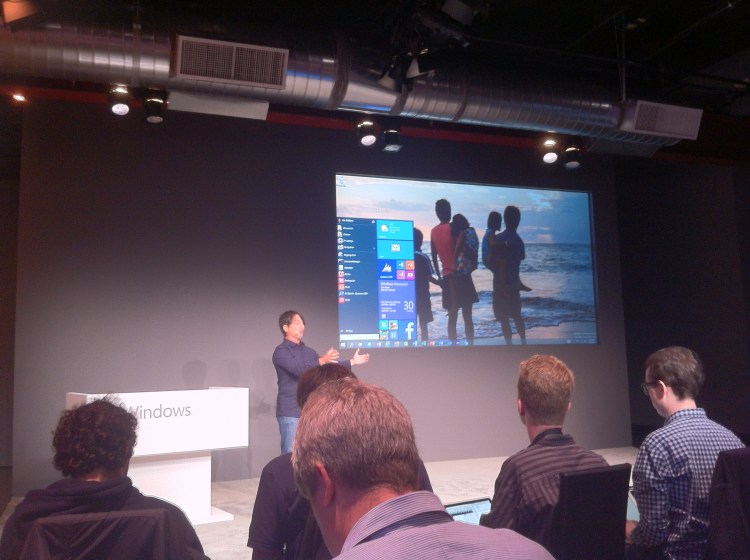Windows 10 is coming out next year, and it’s a substantial revision to Windows 8. VentureBeat’s Devindra Hardawar called it Microsoft’s big fat apology for Windows 8.
Maybe the company needed to put so much distance between itself and Windows 8 that it skipped all the way over 9.
The fact is, Windows 8 sold pretty damn well — for any company except Microsoft. In its first 15 months, the company shipped 200 million licenses for Windows 8. Most companies would kill for that kind of market.
But that’s 100 million fewer licenses than Microsoft sold in the same period after launching Windows 7. A 33 percent decline from one version to another is the kind of problem that gets CEOs fired, or at least gracefully retired, and leads their replacements to announce bold new changes of direction. That’s exactly what new Microsoft chief Satya Nadella did, and we’re now beginning to see how his new strategy is playing out.
For starters, Windows 10 appears to be less focused on the touchscreen market — but it hasn’t abandoned touchscreens entirely. It still has the Start screen and all those touch-friendly gestures that the company introduced in Windows 8, but they’re less prominent. Instead, it’s bringing back the Start menu as the default starting point for most users. The Start screen is still there, but you have to enable it manually (if you’re a Surface user, for instance, you might want this). The upcoming “Continuum” feature will change the Start menu from a mouse-friendly version to a more touch-friendly version whenever you detach your keyboard.
And while Microsoft hasn’t elaborated much on this, it has made it clear that Windows 10 will be the same operating system on phones and desktops and tablets — instead of having a separate OS for phones.
The return of the Start menu is a recognition that, even though the PC market is shrinking, Microsoft still depends on the support of its hundreds of millions of desktop and laptop users. And even though people mocked the Start button when it first appeared in Windows 95, after a couple decades of using it, we’re kind of used to it now.
It’s a tough position for Microsoft. It knows that the PC is no longer the central device for many people, and the trend lines are clear: More and more people are using tablets, or even smartphones, as their primary devices. PC shipments declined for eight straight quarters, from 2012 through early 2014, Gartner reports — a decline of such long standing that “flat growth” (also known as no growth) actually looked pretty good in the second quarter of 2014. Still, that was 75.8 million computers for the quarter.
By comparison, tablet shipments totalled 49.3 million in the same quarter, according to IDC figures assembled by TabTimes, and will probably grow 25 percent for the year.
To summarize these figures: PC sales are stablizing after a long period of decline, while tablet sales continue to grow — but perhaps not everywhere — and approach parity with PC sales.
My take is that PCs aren’t exactly going away, but for most people, they’re no longer the machine you live with day in and day out. Instead, they’re turning into special purpose devices. PCs and laptops are the things you use to get work done or play games on, or the things that run business software in a corporate office or on a factory floor.
Microsoft, which understands business customers better than almost anyone else, has been trying to make an operating system that bridges the dying PC market and the possibly burgeoning tablet market. That’s why those touchscreen features are still there. But that’s also why the company is reviving the mouse-centric interface features it tried hard to suppress in the last version.
How long can Microsoft maintain this delicate balancing act? It is a big enough company, with enormous revenues from both its platform and productivity divisions, that it could probably continue to earn profits and deliver dividends to its shareholders for another half a decade or more without making any major changes.
But at some point, it’s going to wake up in a world where people live primarily in the cloud, access that cloud through a variety of devices, and care less about the device and its OS than they do about the content and their cloud platforms. If Microsoft isn’t careful, those devices could be Chromebooks or MacBooks instead of Windows PCs and tablets.
In short, Microsoft has one or maybe two more versions of Windows to get it right. If Windows 10 doesn’t convince people that it’s the right OS to bet on for the future of desktops, tablets, and phones, Microsoft won’t have too many more opportunities. And then it will be time for the company to settle in for a comfortably long decline into irrelevance.
VentureBeat's mission is to be a digital town square for technical decision-makers to gain knowledge about transformative enterprise technology and transact. Learn More

